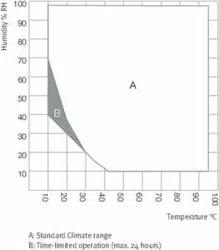Loading ...
Loading ...
Loading ...

MKF / MKFT (E5) 06/2020 page 86/176
12.3 Over/under temperature safety device class 2 (option)
Example: MKF 56
The over-/under temperature safety device (4) consists of two entry mod-
ules (4a) and (4b) located in the lateral contro
l panel. Both modules can be
set from -50 °C / -58 °F (MKF) / -80 °C / -112 °F (MKFT) up to 200
°C /
392 °F and serve to define the maximum high and low temperature limits.
With this option, the safety controller (chap. 12.2) must be set to
maximum temperature.
(4a) Upper module: Entry of higher limit temperature.
(4b) Lower module: Entry of lower limit temperature.
When the temperature inside the chamber leaves this tolerance band-
width, the temperature control, and herewith the heating and refrigeration,
are turned off permanently.
At the corresponding entry module, the pilot lamp “1” lights up.
The controller displays the alarm message “Temp. safety device”
(chap.
11.1.2
). Additionally there is an audible alert, provided that the buzzer has
not been deactivated (chap. 11.4).
Let the chamber heat up or cool down to the defined safety temperature
range.
Then reset the alarm message on the controller (chap. 11.3). to re-
activate
the chamber. The pilot lamp “1” goes off
as soon as the temperature will
again be below / above the threshold.
Setting limit temperatures at modules (4a) and (4b):
The upper line shows the actual temperature. The bottom line shows
the set-point of the limit temperature.
• Press the arrow-up or arrow-down key
The display changes to entry mode: The set-
point in the bottom
line flashes
• Enter the desired limit temperature via the arrow keys and con-
firm with the “OK” button.
• Press the Back button.
The set-point in the bottom line stops flashing.
Function check:
Check the over/under temperature safety device class 2 at appropriate intervals for its functionality. It is
recommended that the authorized operating personnel should perform such a check, e.g., before starting
a longer work procedure.
Loading ...
Loading ...
Loading ...
